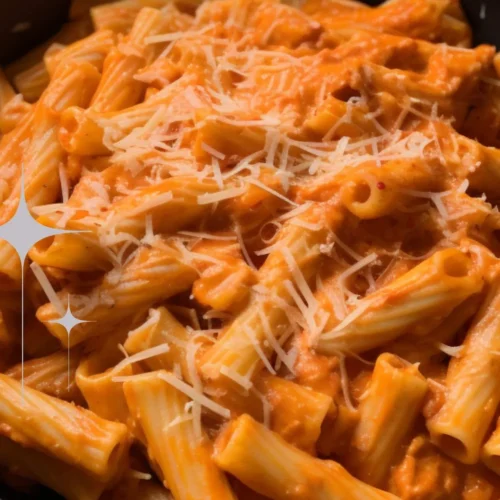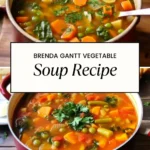Last Updated on February 19, 2024
Let me take you on a culinary adventure, where Korean and Italian flavors collide to create one unforgettable dish – gochujang vodka pasta. This mouthwatering recipe is the perfect marriage of spicy gochujang paste, creamy vodka sauce, and al dente pasta.
Get ready to embark on a flavor-packed journey that will leave your taste buds begging for more.

What is Gochujang Vodka Pasta?
Gochujang vodka pasta is a unique twist on the classic vodka sauce pasta dish. It incorporates gochujang paste, a key ingredient in Korean cuisine known for its deep, complex flavors and a kick of heat.
The combination of creamy vodka sauce with a spicy punch from gochujang creates a harmonious fusion that takes this pasta dish to a whole new level.
Why This Recipe Works?
There are several reasons why this gochujang vodka pasta recipe is a winner:
1. Bold and Exciting Flavors: The gochujang paste adds a spicy and umami-rich element to the traditional vodka sauce, elevating the flavor profile of the dish.
2. Easy to Make: This recipe requires minimal ingredients and is simple to prepare, making it accessible for both beginner and experienced home cooks.
3. Versatility: Gochujang vodka pasta can be customized to suit individual preferences. Adjust the amount of gochujang paste and red pepper flakes to control the level of spiciness.
4. Crowd-Pleaser: Whether you’re cooking for your family or hosting a dinner party, this dish is guaranteed to impress. The unique combination of flavors will have your guests asking for seconds.

Ingredients You’ll Need To Make This Dish:
To make gochujang vodka pasta, you’ll need the following ingredients:
- Pasta: Serves as the main carbohydrate component of the dish, providing a base for the sauce and other ingredients. The type of pasta used can vary based on personal preference, with options such as spaghetti, penne, or fettuccine.
- Butter: Adds richness and flavor to the sauce, contributing to a creamy texture and enhancing the overall taste of the dish.
- Shallots: Provide a subtle onion flavor that is milder and sweeter than regular onions. They add depth of flavor to the sauce without overpowering the other ingredients.
- Garlic: Adds aromatic flavor to the sauce, enhancing its complexity and depth. Garlic pairs well with the other ingredients and contributes to the savory profile of the dish.
- Tomato paste: Adds richness, depth, and a hint of sweetness to the sauce. It also helps thicken the sauce and provides a balanced tomato flavor.
- Gochujang paste: Adds a unique spicy and savory flavor to the dish, with hints of sweetness and umami. Gochujang is a Korean fermented chili paste that adds depth and complexity to the sauce.
- Red pepper flakes: Provide additional heat and flavor to the dish, complementing the spiciness of the gochujang paste and adding a subtle kick.
- Vodka: Adds depth of flavor and a subtle boozy note to the sauce. Vodka helps enhance the flavors of the other ingredients and contributes to a smoother texture.
- Heavy cream: Provides richness and creaminess to the sauce, creating a luscious texture and balancing the spiciness of the gochujang paste.
- Parmesan cheese: Adds nutty and salty flavor to the sauce, enhancing its richness and depth. Parmesan cheese also helps thicken the sauce and contributes to a creamy consistency.
- Salt: Enhances the flavors of the other ingredients and helps balance the overall taste of the dish.
- Pepper: Adds a touch of heat and complements the other flavors in the dish. Freshly ground black pepper adds depth and complexity to the sauce.
How To Make Gochujang Vodka Pasta?
Step 1: Cook the Pasta
– Fill a large pot with salted water and bring it to a boil.
– Add the pasta and cook until al dente, following the instructions on the package.
– Once cooked, drain the pasta but reserve a cup of the pasta water for later use.
Step 2: Prepare the Sauce
– Heat a large skillet over medium heat and add 2 tablespoons of butter.
– Once melted, add the diced shallots and minced garlic, sautéing until they become translucent and fragrant.
– Add the tomato paste, gochujang paste, and red pepper flakes to the skillet, stirring them into the shallot mixture.
– Cook for a few minutes to develop the flavors.
Step 3: Add the Vodka and Cream
– Pour the vodka into the skillet and let it simmer for a minute or two to cook off the alcohol.
– Stir in the heavy cream, ensuring it is well incorporated with the sauce.
– Let the sauce simmer for a few minutes until it thickens slightly.
Step 4: Combine the Pasta and Sauce
– Add the cooked pasta to the skillet and toss it gently to coat the pasta evenly with the sauce.
– If the sauce appears too thick, add some of the reserved pasta water, a little at a time, until you achieve your desired consistency.
– Season with salt and pepper to taste.
Step 5: Serve and Garnish
– Transfer the gochujang vodka pasta to serving plates or bowls.
– Top with freshly grated Parmesan cheese to enhance the flavors.
– Serve immediately and enjoy the delightful marriage of Korean and Italian cuisine.
Tips & Tricks:
– Experiment with Different Pasta Shapes: While rigatoni works wonderfully in this dish, feel free to venture out and try other pasta shapes like penne or fusilli for a unique twist.
– Adjust the Spice Level: If you prefer a milder version, reduce the amount of gochujang paste and red pepper flakes. Alternatively, if you enjoy a fiery kick, add more to suit your taste.
– Freshly Grated Parmesan Cheese: Using freshly grated Parmesan will elevate the flavors of the dish, adding a nutty and salty element that complements the gochujang and vodka sauce perfectly.
– Pair with a Fresh Salad: A vibrant green salad with a tangy vinaigrette will provide a refreshing contrast to the spicy and creamy pasta.
– Use High-Quality Ingredients: Since this recipe relies on simple ingredients, using high-quality gochujang paste, vodka, and Parmesan cheese will make a noticeable difference in the final result.

Nutrition Information:
As with any pasta dish, gochujang vodka pasta is a rich and satisfying meal. The nutritional value will vary depending on portion size and specific brand ingredients used. Here is an approximate breakdown per serving:
– Calories: 600
– Fat: 25g
– Carbohydrates: 74g
– Protein: 15g
– Fiber: 4g
How Do You Store The Leftovers?
If you find yourself with leftovers of this scrumptious gochujang vodka pasta, fear not, as it stores well for later enjoyment. Simply transfer the pasta to an airtight container and refrigerate for up to three days.
To reheat, place the pasta in a skillet with a splash of water or cream, and gently warm it over medium heat, stirring occasionally to prevent sticking. Add a sprinkle of Parmesan cheese and voila! A delicious meal in minutes.
What sides would complement Gochujang Vodka Pasta?
While gochujang vodka pasta stands beautifully on its own, pairing it with complementary sides can enhance the overall dining experience. Here are three suggestions:
1. Garlic Bread: Crusty, garlicky bread is a classic accompaniment to any pasta dish. The warm, buttery slices will not only satisfy your carb cravings but also act as a vehicle for scooping up the remaining sauce.
2. Grilled Vegetables: Lightly charred and caramelized grilled vegetables such as zucchini, bell peppers, and mushrooms can add a refreshing contrast to the rich and spicy pasta.
3. Korean Banchan: A selection of traditional Korean side dishes, known as banchan, can elevate your gochujang vodka pasta feast. Some popular options include kimchi, pickled vegetables, and soybean sprouts.
What alternatives can you use for the ingredients if they are not present in your kitchen?
If some of the ingredients listed for gochujang vodka pasta are not readily available in your kitchen, here are some alternatives you can use:
1. Pasta: While rigatoni is recommended for this recipe, other pasta shapes such as penne, fusilli, or even spaghetti will work well.
2. Shallots: If you don’t have shallots on hand, you can substitute them with onions. However, keep in mind that the flavor profile will be slightly different.
3. Heavy Cream: To achieve a creamy sauce, you can substitute heavy cream with half-and-half or whole milk. However, the sauce may be slightly lighter in texture.
4. Parmesan Cheese: If you don’t have freshly grated Parmesan cheese, feel free to use pre-shredded Parmesan or other similar hard cheeses such as Pecorino Romano or Grana Padano.

Gochujang Vodka Pasta
Equipment
- Sauté Pan
- Chef Knife
- pot
- Microplane Grater
- Cutting Board
Ingredients
- 2 Shallots diced
- 4 tbsp Butter divided
- 3 tbsp Tomato Paste
- 4 cloves Garlic minced
- 1 cup Heavy Cream
- 1/4 cup Vodka
- 1/4 cup Parmesan Cheese freshly grated; more to serve
- 3 tbsp Gochujang Paste
- Salt and Pepper to taste
- 1 lb Pasta
- 1/4 tsp Red Pepper Flakes optional; more or less to taste
Instructions
Step 1: Cook the Pasta
- – Fill a large pot with salted water and bring it to a boil.
- – Add the pasta and cook until al dente, following the instructions on the package.
- – Once cooked, drain the pasta but reserve a cup of the pasta water for later use.
Step 2: Prepare the Sauce
- – Heat a large skillet over medium heat and add 2 tablespoons of butter.
- – Once melted, add the diced shallots and minced garlic, sautéing until they become translucent and fragrant.
- – Add the tomato paste, gochujang paste, and red pepper flakes to the skillet, stirring them into the shallot mixture.
- – Cook for a few minutes to develop the flavors.
Step 3: Add the Vodka and Cream
- – Pour the vodka into the skillet and let it simmer for a minute or two to cook off the alcohol.
- – Stir in the heavy cream, ensuring it is well incorporated with the sauce.
- – Let the sauce simmer for a few minutes until it thickens slightly.
Step 4: Combine the Pasta and Sauce
- – Add the cooked pasta to the skillet and toss it gently to coat the pasta evenly with the sauce.
- – If the sauce appears too thick, add some of the reserved pasta water, a little at a time, until you achieve your desired consistency.
- – Season with salt and pepper to taste.
Step 5: Serve and Garnish
- – Transfer the gochujang vodka pasta to serving plates or bowls.
- – Top with freshly grated Parmesan cheese to enhance the flavors.
- – Serve immediately and enjoy the delightful marriage of Korean and Italian cuisine.
Notes
- – Experiment with Different Pasta Shapes: While rigatoni works wonderfully in this dish, feel free to venture out and try other pasta shapes like penne or fusilli for a unique twist.
- – Adjust the Spice Level: If you prefer a milder version, reduce the amount of gochujang paste and red pepper flakes. Alternatively, if you enjoy a fiery kick, add more to suit your taste.
- – Freshly Grated Parmesan Cheese: Using freshly grated Parmesan will elevate the flavors of the dish, adding a nutty and salty element that complements the gochujang and vodka sauce perfectly.
- – Pair with a Fresh Salad: A vibrant green salad with a tangy vinaigrette will provide a refreshing contrast to the spicy and creamy pasta.
- – Use High-Quality Ingredients: Since this recipe relies on simple ingredients, using high-quality gochujang paste, vodka, and Parmesan cheese will make a noticeable difference in the final result.
Nutrition
Frequently Asked Questions:
Q1: Can I make gochujang vodka pasta without alcohol?
A1: Absolutely! If you prefer not to use alcohol in your cooking, you can omit the vodka altogether. The sauce will still be deliciously creamy with the addition of heavy cream and other ingredients.
Q2: Can I make this dish vegetarian or vegan-friendly?
A2: Yes! If you follow a vegetarian or vegan diet, you can easily adapt this recipe. Replace the butter with a plant-based alternative and use dairy-free heavy cream or cashew cream for a vegan-friendly creamy sauce.
Q3: Is gochujang spicy?
A3: Gochujang paste does have a level of spiciness to it, but the intensity can vary depending on the brand and personal tolerance for heat. You can control the spice level in this recipe by adjusting the amount of gochujang paste and red pepper flakes used.
Q4: Can I freeze gochujang vodka pasta?
A4: It is not recommended to freeze this dish, as the cream-based sauce may separate and become grainy upon thawing and reheating.
Q5: Can I add meat or seafood to this recipe?
A5: Absolutely! If you prefer a heartier meal, you can add cooked chicken, shrimp, or even ground meat to the sauce. Simply cook the protein separately and add it to the dish during the final step.
Q6: Can I make this dish ahead of time for a party?
A6: While the flavors of the dish are best enjoyed immediately, you can prepare the sauce in advance and store it in the refrigerator. When ready to serve, cook the pasta, reheat the sauce, and combine the two for a quick and delicious meal.
In Conclusion:
Gochujang vodka pasta is a culinary masterpiece that combines the best of Korean and Italian cuisine. The spicy kick from gochujang paste adds a new dimension of flavor to the classic vodka sauce, creating a dish that is both exciting and comforting.
With its simple preparation and crowd-pleasing taste, this recipe is sure to become a favorite in your household. So grab your apron, gather the ingredients, and get ready to indulge in a truly unforgettable dining experience.




